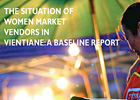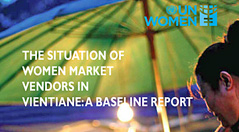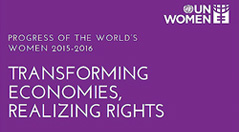
Launch of UN Women Publications in Lao PDR

Event description
Since initiating economic reforms in the mid-1980s, Lao People’s Democratic Republic (Lao PDR) has accomplished notable economic and social development improvements. According to the World Bank (2014), it is one of the fastest-growing economies in the region. With an average 7 per cent increase in gross domestic product over the last two decades, it has the highest growth rate in South-east Asia.
Many economic and social challenges remain, however. Large differences are evident in the development levels of men and women, and among women. Those in vulnerable groups—ethnic minorities, informal workers, poor, educated at a low level, living with disabilities or residing in remote areas—encounter greater obstacles to jobs, services and other fundamentals of well-being.
The small-scale business sector is dominated by Lao women, the vast majority of whom are in one or more vulnerable groups. According the Gender Resource Information and Development Centre (2006), a lack of education and economic opportunities and limited access to resources drive women into the informal sector and small-scale enterprises. Women in informal sector often face challenges such as limited knowledge of financial management, lack of capital, unsafe working environments, limited mobility due to household responsibilities, negative cultural norms, exploitation, discrimination, lack of protective services, inadequate knowledge about laws and policies, and weak support from government.
Gender equality has been addressed as a crosscutting issue in the 8th National Socio-economic Development Plan (NSEDP) 2016-2020. At the same time, National Development Plan for Gender Equality 2016-2020 and Lao Women Development Plan 2016-2020 which includes Women’s Economic Empowerment Programme were endorsed. The Budget Law that includes an element of gender-responsive budgeting has been passed.
UN Women has recently published the global report on Progress of the World’s Women 2015-2016: Transforming economies, realizing rights, reflecting implementation of the Beijing Platform for Action, adopted in 1995.
The report provides current status of gender equality across the world and the evidences and recommendations for actions to address the gaps in order to achieve sustainable development goals. In addition, this report focuses on the economic and social dimensions of gender equality, including the right of all women to a good job, with fair pay and safe working conditions, to an adequate pension in older age, to health care and to safe water without discrimination based on factors such as socio-economic status, geographic location and race or ethnicity. The findings and recommendations from this report reflect the commitments and obligations of Lao government on the implementation of CEDAW as well as national strategies and action plan related to women economic empowerment. The executive summary of this report was translated and printed in Lao language. At the country level, in order to generate the evidence based for program development on women economic empowerment and to advocate for gender responsive policy and legal framework, UN Women Program Office in Lao PDR completed a situational analysis on women market vendors in Vientiane in June 2016.
Women represent more than 90 per cent of vendors in fresh food markets across the country. Their roles often go unrecognized, however. Even though they manage entire value chains from production to sales, they are poorly organized and represented in decision-making body of the markets. Women vendors lack awareness, knowledge, skills and access to credits. This baseline study investigated relevant laws and policies concerning women vendors, with a view to better understanding their situation in Vientiane Capital. The validation workshop was carried out. The findings and recommendations were validated by multi-stakeholders and incorporated in the final report.
The two UN Women reports are linked and complement each other. Both reports analyze the issues of women’s economic and social rights, voice and participation. These reports can be used as references to increase knowledge as well as the policy advocacy tools. National Assembly of Lao PDR under the new 8th legislative approved the 8th NSEDP in April 2016 which will be implemented by the new cabinet.
The proportion of female members at the National Assembly is 27.5 per cent and its president is a woman. While Lao PDR is committed to increase the proportion of women in decision-making, the per centage at other decision-making institutions is about 5 per cent. There is little gender disparity in the labour force participation. However, the greatest proportion of women engage in vulnerable work including informal work, self-employed or unpaid work for the family business. It has been reported that women take up four times more house chores and care work than men, creating a double burden for many working women. Also, the wage gap between male and female workers is noticeable. Lao population is still largely dependent on subsistence agriculture (71 per cent of the total labour force). Many are de facto farmers as employment opportunities in the rural areas are scarce. Even if women have significant roles in agriculture, they have limited access to and control over farming inputs and credits.
Against this backdrop, UN Women Program Office in Lao PDR is organizing the launch of Progress of the World’s Women 2015-2016: Transforming economies, realizing rights, and Baseline Study on Situation of Women Market Vendors in Vientiane Capital.
The Launch will share the findings and recommendations of the two reports, with a view to increase and raise awareness on gender aspects of economic policies and potential impacts of economic policies as well as interconnectedness between global and local gender issues.

